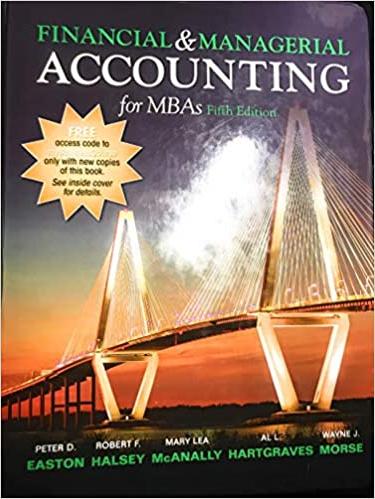Question
For the past year, WoolCo has experimented with its third product, extra-thick rug yarn. The company wishes to consider whether to continue or discontinue manufacturing
For the past year, WoolCo has experimented with its third product, extra-thick rug yarn. The company wishes to consider whether to continue or discontinue manufacturing and selling this product. You decide to prepare a differential analysis of the income related to all three products. To begin your analysis, you review the following Condensed Income Statement. Then scroll down to complete the differential analysis.
| WoolCo |
| Condensed Income Statement |
| For the Year Ended December 31 |
| 1 |
| Raw Wool | Wool Yarn | Rug Yarn | Total Company |
| 2 | Sales | $210,000.00 | $155,000.00 | $197,000.00 | $562,000.00 |
| 3 | Cost of goods sold: |
|
|
|
|
| 4 | Variable costs | $48,000.00 | $18,600.00 | $37,160.00 | $103,760.00 |
| 5 | Fixed costs | 32,000.00 | 12,400.00 | 24,780.00 | 69,180.00 |
| 6 | Total cost of goods sold | $80,000.00 | $31,000.00 | $61,940.00 | $172,940.00 |
| 7 | Gross profit | $130,000.00 | $124,000.00 | $135,060.00 | $389,060.00 |
| 8 | Operating expenses: |
|
|
|
|
| 9 | Variable expenses | $5,000.00 | $7,750.00 | $53,120.00 | $65,870.00 |
| 10 | Fixed expenses | 89,000.00 | 77,500.00 | 106,200.00 | 272,700.00 |
| 11 | Total operating expenses | $94,000.00 | $85,250.00 | $159,320.00 | $338,570.00 |
| 12 | Income (loss) from operations | $36,000.00 | $38,750.00 | $(24,260.00) | $50,490.00 |
Complete the table using the data in the income statements previously shown to compare the effects of dropping the rug yarn line of products. For those boxes in which you must enter subtracted or negative numbers use a minus sign. If an amount is zero, enter 0.
| Differential Analysis |
| Continue Rug Yarn (Alternative 1) or Discontinue Rug Yarn (Alternative 2) |
| December 31 |
| 1 |
| Continue Rug Yarn (Alternative 1) | Discontinue Rug Yarn (Alternative 2) | Differential Effect on Income (Alternative 2) |
| 2 | Revenues |
|
|
|
| 3 | Costs: |
|
|
|
| 4 | Variable |
|
|
|
| 5 | Fixed |
|
|
|
| 6 | Total Costs |
|
|
|
| 7 | Income (loss) |
|
|
|
Answer the following questions (1) and (2), then fill in table (3).
1. After reviewing your work on the Traditional Costing and Activity-Based Costing panels, which costing method would you recommend to WoolCo, and why?
Since both the methods give the same costs for each product, there is no advantage to either method.
The company should use whichever method is the cheapest to implement.
Activity-based costing, because it recognizes differences in how each product uses factory overhead activities, yielding more accurate product costs.
Traditional costing, because it is a tried-and-true method used for the entire life of the company.
2. After reviewing your work on the Continue/Discontinue panel, should WoolCo continue (Alternative 1) or discontinue (Alternative 2) the rug yarn product line?
Discontinue (Alternative 2)
The company is indifferent between Alternative 1 and Alternative 2
Continue (Alternative 1)
3. The following table shows several business decisions that might need to be made across the top row. Along the left-hand column, there are important factors to consider.
Choose the factor(s) that are important to the decision. Check all that apply. If the factor is not important to any of the decisions, check the Not Important box.
| Lease or Sell | Sell or Process Further | Special Price Order | Make or Buy | Continue or Discontinue | Production Bottleneck | Not Important | ||
|---|---|---|---|---|---|---|---|---|
| Impact on regular prices |
|
|
|
|
|
|
| |
| Contribution margin per bottleneck hour |
|
|
|
|
|
|
| |
| Differential revenue is more than differential costs |
|
|
|
|
|
|
| |
| Supplier price is less than WoolCos variable cost per unit |
|
|
|
|
|
|
| |
| Sunk costs |
|
|
|
|
|
|
| |
| Robinson-Patman Act |
|
|
|
|
|
|
|
Step by Step Solution
There are 3 Steps involved in it
Step: 1

Get Instant Access to Expert-Tailored Solutions
See step-by-step solutions with expert insights and AI powered tools for academic success
Step: 2

Step: 3

Ace Your Homework with AI
Get the answers you need in no time with our AI-driven, step-by-step assistance
Get Started


